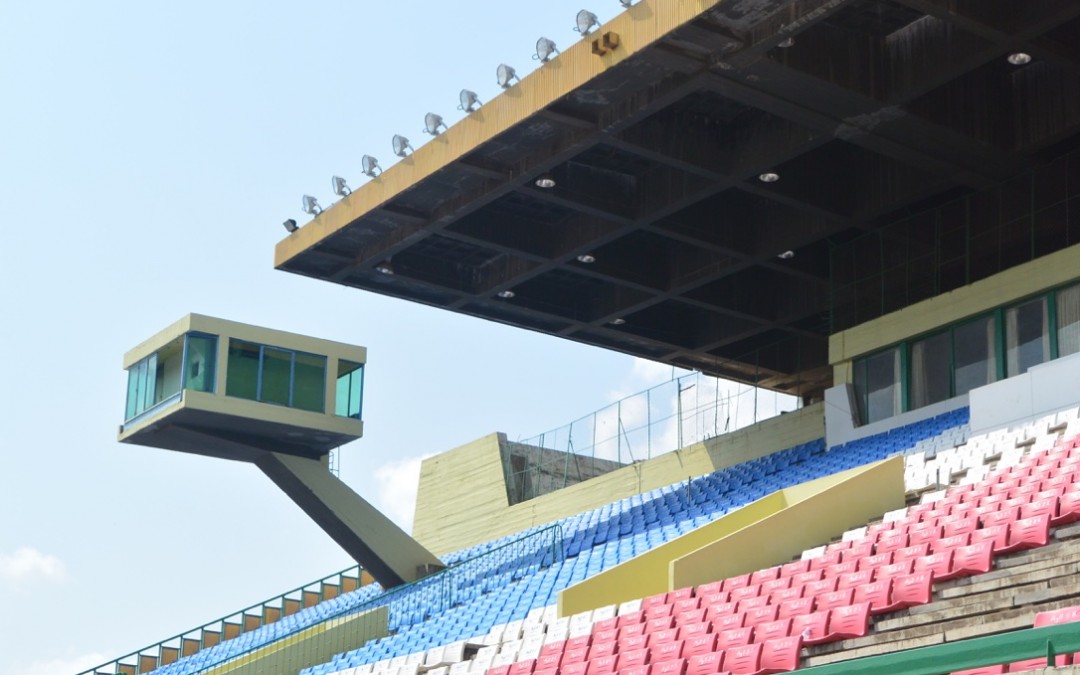
by Nick | Jun 8, 2020 | Blog, Culture
NEW KHMER ARCHITECTURE
Architecture was part of a new exuberant and modernistic Khmer movement encouraged by King Sihanouk and expressed in music, dance, film and architecture, not seen in neighboring parts of Indochina when Cambodia gained independence in 1953. The movement lasted until Sihanouk was deposed by Lon Nol in the 1970 coup, which heralded the start of the civil war.
Vann Molyvann was foremost among the city’s architects during this time, designing nearly 100 public and private projects. He’d studied in France and drew inspiration from Le Corbusier and his five principles of design, most of which can be seen in traditional Khmer wooden houses.
The five principles being;
- The building is raised from the ground
- It has an open facade
- The columns are not connected
- There is a roof top garden
- Concrete and wood are used in the construction
Together with the UN expert Gerald Hanning, he advised the King as to how the city should be developed.
The Institute of Languages The last work of Molyvann before he left the country in 1971 and Sihanouk overthrown was the Institute of Languages, where he used all the devices he’d developed in adapting to the climate with his own unique style. Among these were;
The first floor is larger than the ground floor providing shade below in a style of passive protection, while the whole building is raised on columns from the ground as with traditional Khmer architecture.
A polygon roof separates the working space from the glare and heat of the sun and channels the breeze giving a natural cool. Vertical panels provide shade to the interior
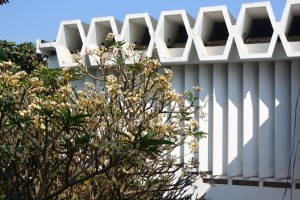 The Institute of Languages showing the cooling polygon roof and shading vertical panels
The Institute of Languages showing the cooling polygon roof and shading vertical panels
The building is orientated to shade the stage and those inside who can see out and those outside in, connecting them by visualization.
The ground floor as with traditional Khmer wooden houses was open though now outside walls have been added on some of the buildings, somewhat of a design travesty but the Ministry of Education doesn’t speak to the Ministry of Culture.
 The main building in The Institute of Languages showing the larger 2nd & 3rd floors shading the ground floor and stage
The main building in The Institute of Languages showing the larger 2nd & 3rd floors shading the ground floor and stage
Arial walkways over pools connect the different buildings offering a view over the forty five hectare campus and shelter from the rain and sun underneath. They give an example of how Molyvann incorporated Angkorian design, which uses bridges to cross the temple moats. He even finished off the handrails with nagas or snakes.
The four lecture halls appear as jumping frogs creating a sense of dynamism, while the double walls faced by brick divert heat from the laboring students inside. And sculpture not painting is used to play with the shadows.
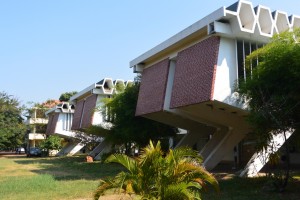 The 4 Lecture Halls
The 4 Lecture Halls
The library (not shown) is shaped like a Khmer straw hat, where outside columns support the building with no structure inside. The gutters act as fountains falling into a surrounding pool cooling the building without the need for air-conditioning (in case of the library aircon was used to control the humidity). A Le Corbusier inspired style called ‘brise soleil’ seen in Chandigargh India, where the walls are protected from the wind, rain and sun, was also used by Molyvann.
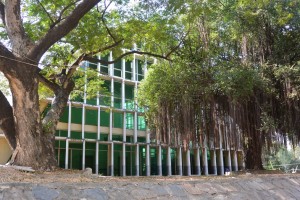 The Conference Hall
The Conference Hall
The conference hall, not designed by Molyvann, is a parabolic shape supported from outside and traditionally open sided which killed the sound and allowed a breeze. Now the sides have been filled with glass it has to be air-conditioned and there’s an echo to even the smallest sound.
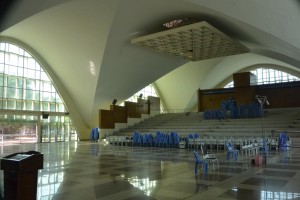 Interior
Interior
There were air vents in the ceiling to further cool the space but they have been covered. There’s a mistake in the orientation of the hall as it faces South West catching the sun unlike the Institute of Languages.
The Hundred Houses The next stop on our tour of new Khmer architecture was The hundred houses, built between 1965 – 1967, providing social housing to National Bank of Cambodia employees who were entitled to the buildings after 20 years paying rent.
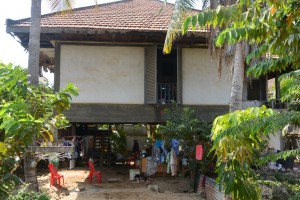 A Hundred House
A Hundred House
The design incorporates that of a Khmer wooden house and modern architecture. The houses appear to be randomly orientated but are actually carefully laid out to maximise the view and space.
The open space underneath is important providing an area for shelter and storage like a traditional Khmer wooden house and there’s an Angkorian style pool in every garden. There are 2 staircases, one into the living room and a back stair to the kitchen and the WC so guests would avoid the smell and traipsing through the house. Unlike most Khmer houses Molyvann designed big windows the size of doors for ventilation and light.
The main columns are made of concrete not wood as are the beams between them. This is so the thickness of the beams can be increased and the span widened, allowing more space. The roof is like a policeman’s helmet raised above the walls and channeling any breeze from outside in.
In 1975 the estate became a military camp and every house got a number. After the civil war the Vietnamese Air Force took them and in 1986 they were given back to the people. Today most are being demolished or altered as land becomes increasingly expensive.
The National Stadium The most spectacular project was saved for last on our tour. The Olympic Stadium started in 1962 was planned for the Asian Games in 1963 but actually finished in 1964. In 1966 it was used for the Non-aligned Asian Games. The architect was Molyvann who worked with a Ukranian engineer named Vladimir Bondetsky.
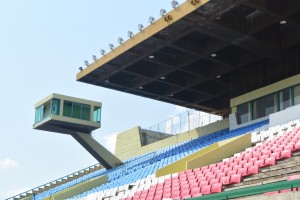 The royal pavilion (top right) with a War of the Worlds timing box over the VIP seats
The royal pavilion (top right) with a War of the Worlds timing box over the VIP seats
 External staircase and tiered seating showing the ventilation holes
External staircase and tiered seating showing the ventilation holes
The building was Angkorian inspired and became known as the second Angkor Wat consuming most of the national budget in its construction.
The materials excepting aluminum panels were all Cambodian. As with Angkor Wat the indoor stadium is surrounded by pools fed from gutters.
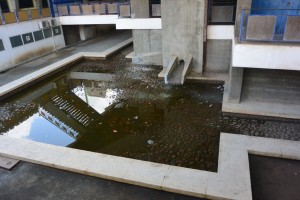 One of the pools surrounding the auditorium showing the guttering and reflecting the stairs
One of the pools surrounding the auditorium showing the guttering and reflecting the stairs
External stairs allow for a speedy and non claustrophobic exit. There are no walls as such just tiers of seating surround the auditorium, each seat has an open space underneath providing cooling ventilation to the entire area. The ceiling is supported by 4 columns 2 meters wide, 25 m high allowing a span of 32 m resembling a square mushroom. The ventilation allowed a breeze and light to get through during the day and the building to glow with light at night.
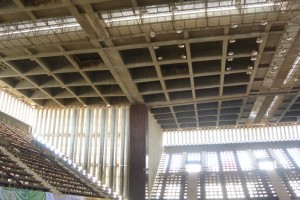 1 of the 4 columns supporting a square 32m span and the tiered seating illuminating the auditorium
1 of the 4 columns supporting a square 32m span and the tiered seating illuminating the auditorium
As you leave the indoor stadium you pass under a low ceilinged corridor, the contrast with the vast space of the 70,000 seat outdoor arena is stunning. As Frank Lloyd Write said detail is the key, this can be seen in all of Molyvann’s designs and the Olympic Stadium is no exception. Originally covering a 24 ha site the different aspects of the complex mirrored each other, while the 4 towers on the roof of the stadium provide orientation around the 4 cardinal points.
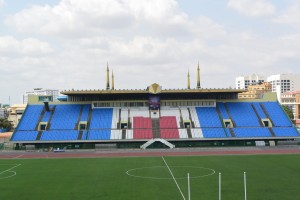 View across the pitch to central auditorium, Royal Box and VIP seating with towers at the 4 cardinal points
View across the pitch to central auditorium, Royal Box and VIP seating with towers at the 4 cardinal points
The elevation of the stadium is the same as Angkor Wat’s and allowed the seats facing East to towards the river to see the Royal Palace. It was built up using the soil from the pools surrounding it, saving money on concrete and speeding up the construction process.
The National Stadium is now under threat and on the World Monument’s Fund watch list. Much of the original 24 ha has been sold for development, the original buildings demolished and construction has started on skyscrapers. There’s talk of a new Chinese funded national stadium on the outskirts of the city, which will increase the pressure to release what is now valuable land.
Phnom Penh can be overlooked in the rush to see the temples from Siem Reap but this Vann Molyvann focused architectural tour along with others concentrating on religious and colonial architecture are a good reason to extend your stay by a night or two.
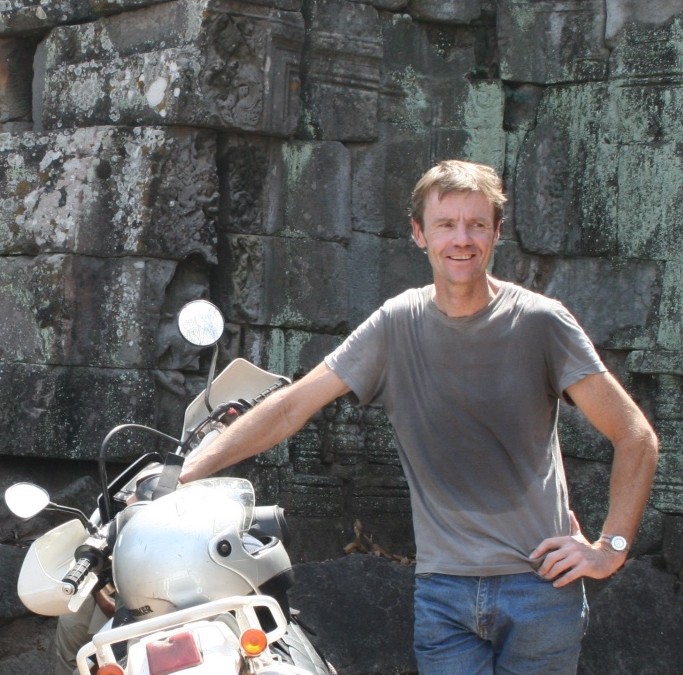
by Nick | Apr 13, 2020 | Angkor, Blog
THE STONE CITIES OF CAMBODIA
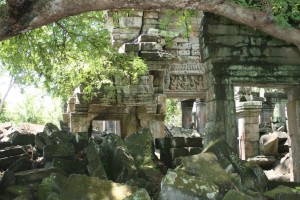 Banteay Chma
Banteay Chma
We cheated. We had a helicopter. It would have taken the late nineteenth century French explorers years to hack through the jungles of Cambodia to alight on the lost Atlantis (plural) that we’d planned for our guests that Christmas Day.
We were at the airport for seven to make the best use of the next ten hours of daylight. Strapped in, our mikes and headsets tuned then that exhilarating sensation as the aircraft seemingly does the impossible and lifts straight up, and if the pilot is feeling playful, does a nose down turn that speeds a few meters above the ground before wheeling up and heading West to our first destination.
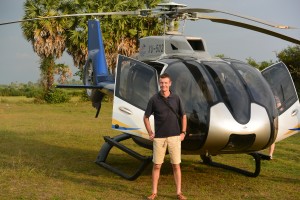 Taking off from Siem Reap Airport
Taking off from Siem Reap Airport
A thousand years ago Jayavarman VII, lets call him JVII ruled his rather large empire via highways that radiated out like the spokes of a wheel that extended to the far flung dominions of the realm, including Route 66 to Thailand by way of Banteay Chma.
Today’s science and earth moving machinery cannot compare to the Angkorians when it comes to the Cambodian landscape. I looked down on the perfectly straight line of the ancient road now marked by a canal that leads to the vast reservoir of Ang Trapaeng Thmor, now a wildlife sanctuary for the endangered Saurus Crane. We flew over the precarious towers of Prasat Troap, a temple I’ve yet to visit and spied the Angkorian city of Banteay Chma.
A site had been cleared for us in a dried out paddy field with a vague H where we were supposed to land then all became lost in a whirlwind of debris from the powerful downward thrust of the rotor-blades. Cold towels and refreshments at the ready, we were lead off to explore JVII’s second largest stone construction after Angkor Thom at Angkor.
Like Angkor Thom his capitol, the towers are adorned with loksvara thought to be a benign image in his likeness. Ever present ever watching, maybe not so benign as they looked over the scheming Hindu priests during his Buddhist reign.
There was a Hindu temple here before, which became integrated into JVII’s construction.

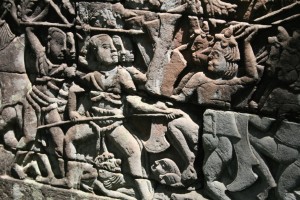 Loksvara (left) Bas-relief on outer gallery wall
Loksvara (left) Bas-relief on outer gallery wall
Despite or maybe because of religious dissent the King allowed a secular society to coexist. He also tolerated a central shrine to his son and the four servants who lost their lives on the frontline defending the crown prince from the marauding Cham.
We walked across the causeway and entered the jumble of towers and galleries, engulfed by foliage and blocked by fallen stones adorned with beautiful carvings.
The outer galleries similar to Angkor Thom are carved with bas-reliefs that seem to come to life as you stare, and act out the battles, religious rituals and daily life of twelfth century Angkor.
We needed to cover a fair chunk of the country to reach the next stone city perched on the Thai border. Strung out for nearly a kilometer along the edge of a 500 meter escarpment in The Dangkrek Mountains. The stone edifice faced North to Thailand and looked out South over what were once the vast forests of Cambodia.
Preah Vihear, which in Sanskrit loosely means sacred shrine was built and added to by successive kings but eleventh century Suryavarman I gets most of the credit. A linear construction built on five levels along the cliff edge with the main structure at the highest point.
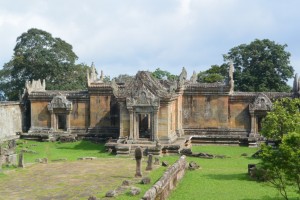
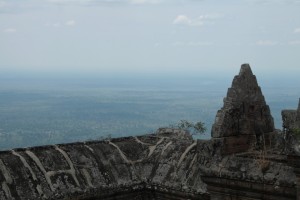 A temple with a view.
A temple with a view.
We touched down beside our 4WD pick up truck, needed for the incline up the mountain and slowly drove into the clouds. Preah Vihear is Cambodian, UNESCO said so but Thailand disagrees, quite violently in 2008 when the Thais started lobbing shells into Cambodia, which were duly returned.
A market on the North side of the temple where bush meat was bought and sold had Thai soldiers milling around as we climbed up the first set of steps towards the summit and the main sanctuary. The temple is stunning but it’s the view I remember.
A quick beer and we were up again with the surreal mountain top temple behind us heading for the lost city of Koh Ker. Lost because the Varman’s had a falling out over Angkor so JIV in a fit of pique upped sticks and built another capitol of the empire. Cambodia’s second largest temple town with the remnants of more than 180 temples spread over 8000 hectares discovered so far and running since Lidar* surveys have revealed more structures, who’s discovery up until recently was hampered by landmines.
*Lidar is a lazer usually mounted on a helicopter that has been used to map out the topography of archeological sites.
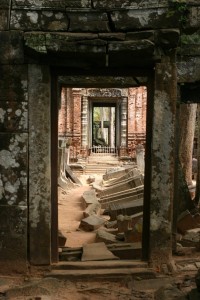 Prasat Thom to Prasat Prang @ Koh Ker
Prasat Thom to Prasat Prang @ Koh Ker
Koh Ker was on a different spoke of the Angkor wheel, which extended via Preah Vihear to Wat Phu in Southern Laos and on to the China Sea. Known as Lingapura or Phallus City, it certainly had some big ones most notably a 4.5 meter statue in Prasat Prang.
The city, which in the early 900‘s had a population of ten thousand is dominated by Prasat Prang, The Pyramid Temple. It rises 35 meters high above the surrounding forest and on a clear day affords views back to the Dangrek Mountains where we’d flown from.
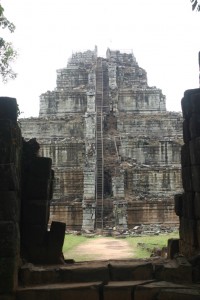 Prasat Prang
Prasat Prang
Where there’s a temple there’s a baray or reservoir and Koh Ker has a big one. Rahal as it was called is over a kilometer long and half a kilometer wide. Surrounded by reasonably protected forest there’s a diversity of birdlife and on it’s banks a great place for a picnic. Three stone cities under our belt so a chilled glass of wine and a spread of cold cuts and salad hit the spot.
Today is a travesty, scholars have studied each of these archeological marvels for years and we’re squeezing in four in one day but beggars cant be choosers so its back into the helicopter for another wonder of the world.
Ta Prohm with its twisting tree roots and Beng Melea overgrown with vegetation are described in the guide books as the jungle temples but the real Indiana Jones fantasy is Preah Khan or The Bakan (Kampong Svay District not Angkor).
I first went to Preah Khan on my dirt bike in 2009, a difficult off road journey along forest paths, fording rivers and crossing flooded paddy fields. More recently we’ve turned the trip into an enjoyable if hard mountain bike ride through a forest from BeTreed about 20km away.
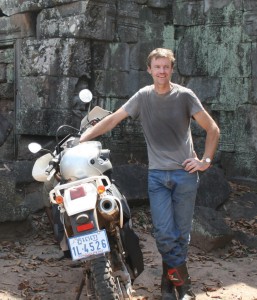 At the entrance to Preah Khan in 2009
At the entrance to Preah Khan in 2009
Wet with sweat and exhausted from the cycle just imagine what it feels like when there in a jungle clearing ahead of you a stone monument testament to the power of the king towers above. A few hundred meters further and the scale of the city revealed itself.
Preah Khan now represented by many ruins covers about 25 square kilometers and includes a three by half a kilometer baray with an island temple in the middle. The Bakan, bigger than Angkor Wat in area is enclosed by five kilometers of walls surrounded by a moat. Like Banteay Chma much of it is a jumble of stones but more spread out such that a visit feels more like a journey.
Different kings left their mark, Suryavarman I in the 10th century dedicated what he built to Shiva but as with most of the mega temples of Angkor it was JVII who really left his mark with a purpose.
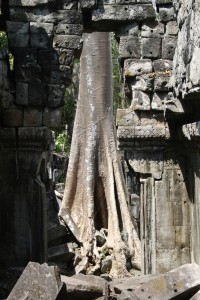
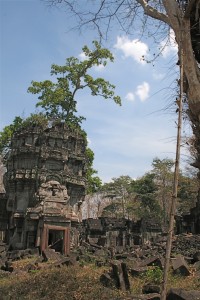 A silk cotton tree as seen through the broken doorway of a temple (above) and part of the Bakan being reclaimed by the forest
A silk cotton tree as seen through the broken doorway of a temple (above) and part of the Bakan being reclaimed by the forest
The area around Preah Khan was rich in iron ore and the local Kouy people a distinct indigenous group had learnt how to make iron, necessary for the weapons JVII needed to defeat the Cham who’d occupied Angkor.
Our aircraft had caused the usual excitement with the general populace emerging to watch the big event as the helicopter landed but inside the temple we were left along. Carefully picking our way through the stones contemplating the surrealism of what, for a short time, we were part of.
All too soon we were back in the helicopter flying over a rural landscape of paddy fields and patches of forest. Too much in one day but an awesome experience!
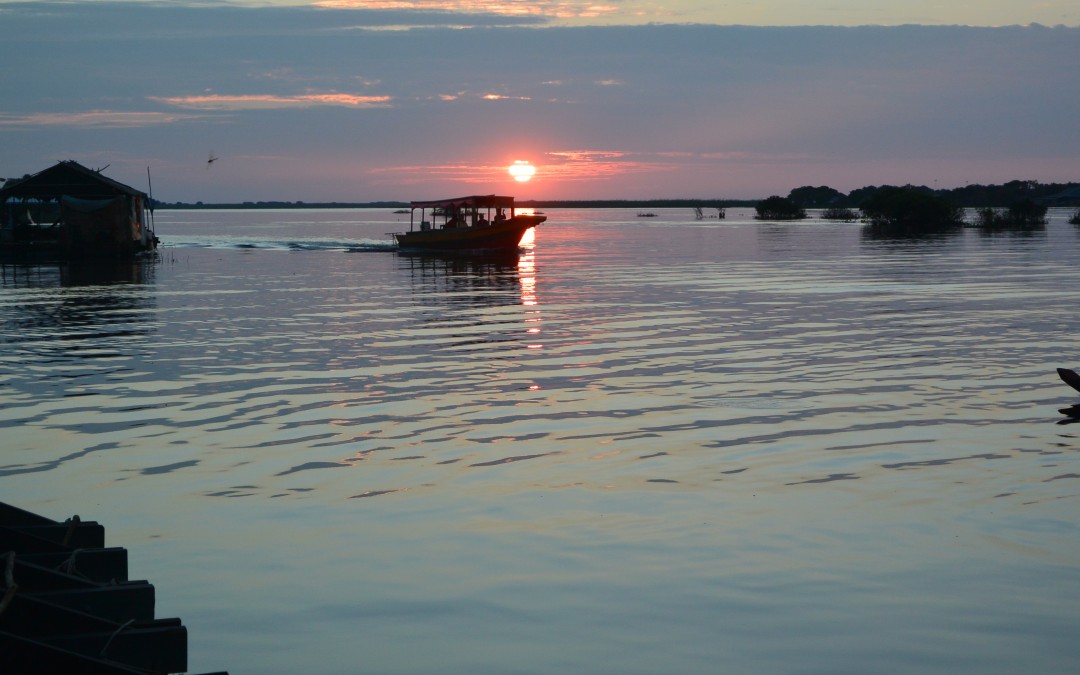
by Nick | Apr 2, 2020 | Blog, Cambodian Journeys, Conservation, Culture, Kayak, Uncategorized
Lena & Seb’s Battambang Adventure
Day 1
Vans, big motorboats, little motorboats, kayaks, bicycles, trains and taxis all had a part to play in our adventure on route from Siem Reap to Battambang. Overnight in the floating village of Prek Toal and the flooded forests of the Core Bird Reserve. Across the floodplains of the Tonle Sap Great Lake and up the Sangke River through the lush rural countryside of Battambang Province to the centre of the farming town in twenty four hours and a bit.
The expedition started at the boat station near Maichrey floating village, where Mr Heang and Finfoot, our comfortably converted fishing boat were waiting. The water was still high enough for us to cross the flooded scrub where we moored to a submerged tree. Lena and Seb were apt pupils as I explained the hydrological phenomena of the Mekong River system until I was rudely interrupted by a virulent green pit viper wrapped around a branch overhanging the deck.
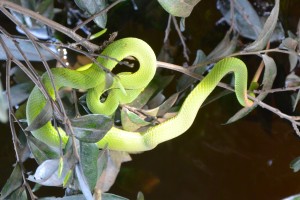 Pit Viper in tree beside boat
Pit Viper in tree beside boat
The afternoons adventure was to explore Prek Toal floating village and the surrounding flooded countryside by kayak. The police chief took photos as we paddled past his station, children came out to stare as we floated by their houses, while those who were working ignored us.
Our improvised route went between the blackened trunks of flooded trees, under their dense green canopy and emerged beside the floating Catholic Church. We crossed the channel to where a muscled boy was ladling fish into piles in front of squatting ladies who chopped them up with meat cleavers, making a pulp that would ferment into Prahoc or Khmer cheese. So named because it stinks.
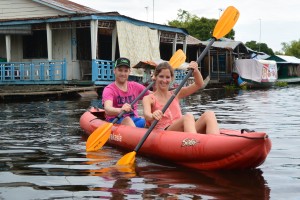 Seb and Lena setting off from their homestay
Seb and Lena setting off from their homestay
We watched the sun – a blood red orange, set over the Core Bird Reserve from the watchtower on top of the environmental research station, then motored over to the Saray Platform for supper.
 Sunset over the Prek Toal Core Bird reserve
Sunset over the Prek Toal Core Bird reserve
Reflections twisted by the wake of motorboats, a cool breeze playing over the boat’s spume.
Hosing the prahok tables ready for tomorrow. Alien clumps of hyacinth drifting on the water.
Single pin pot lights overly bright in the blackness.
Cotton wool fluff of half seen cloud and the glare of a television set as we came close to people’s houses.
The women weavers on the water hyacinth workshop had gone home but their piers were cooking us a supper of fish, vegetables and fruit with rice and a good bottle of chardonnay to wash it down.
Swinging in a hammock in Veasna’s house our home for the night. Manus hid a lime in Baby Buntha’s nappy. His sister heaved the heavy little lump across the floor. The Mother in Law busied herself with not much. The Grandmother on all fours played with the baby. Little sister went skipping to her mummy then wrapped the baby in plastic, all the while pool hall play by the lads in the village. Hide and seek by the water jar, doubled up Grandmother.
Day 2
Streaky orange lighting the village as the first long tails cacaphonic clatter echoed across the water, the old lady hawked, the batteries ran out on the night lanterns. We awkwardly crossed the tilting boats to the pool hall barge to meet Heang, who took us for breakfast back at the Saray Platform.
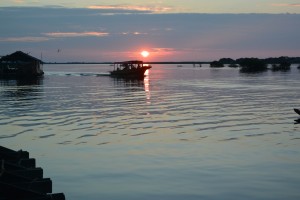 Dawn over Prek Toal
Dawn over Prek Toal
Bunhoeurn was waiting in the community boat for the ride into the magical landscape of the post dawn flooded forest. The light of the warming sun reflected by the delicate yellow flowers of floating saray plants. Squadrons of cormorants flew in slip-stream formation. A profusion of black and white; Oriental darters mixed with egrets, pelicans riding the thermals like galleons in the sky and the bird colonies. Avian cities built in the tallest trees.
Back in the village by 9am our journey into the heart of darkness (actually lush, pastoral Battambang) began.
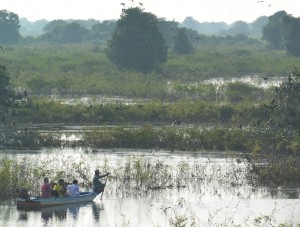
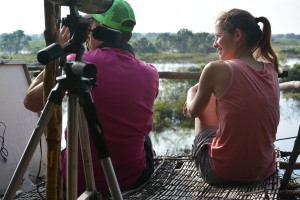
The core bird reserve & view from observation platform
The waterway was fringed by hyacinth and undulating green margins of scrub with the occasional hamlets of floating houses or shacks tied to trees. The first proper village was Kampong Prahoc, which sort of translates into waterside place of good fermented fish paste. I wouldn’t want to be there when the water is low and rotten fish undiluted!
After an hour or so we began to get an idea of how vast the floodplain is. Over 40 kilometres wide where the water rises and falls by 10 meters submerging all but the tallest trees. In the floating villages along our route the only permanent constructions were pagodas on stilts.
Around a bend and Wat Cheu Khmao or temple of the black wood, came into view like a Burmese monastery with a beautiful modern pagoda framed by sugar palms behind. It was built in 1944 copying the Bayon Temple in Angkor and completed with Loksvara, the smiling faces at the cardinal points but they were blamed after accidents and disease struck the village then removed.
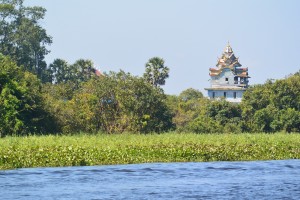 The salapali or space for teaching of Wat Cheu Kmao
The salapali or space for teaching of Wat Cheu Kmao
Great clumps of yellow green bamboo towered over the floating houses. The stems are harvested to provide the floating platforms on which the villages are built.
A regal Grey-headed fish eagle on guard beside its nest in a tall tree, while on a lower branch a hunched up night heron the servile vizier to the magnificent bird above.
We passed a tacky tourist lunch stop as bad as any bus station for the back packers crammed inside and on top of the fibreglass tourist boat.
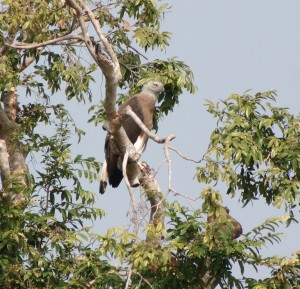 Grey-headed Fish Eagle
Grey-headed Fish Eagle
A single file short cut through the scrub, stopping for long tail boats loaded with beer and rice and wooden boats with giant water jars. We emerged onto an open plain where the trees had been cut down. Home to a transient people living on their small house-boats or shelters on the river bank as the water receded. Strange pivoting bamboo fishing nets were lowered into the water then raised revealing a whicker basket tied to the bottom to trap the fish.
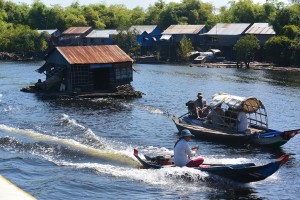 A floating house being towed to deeper water through a village of stilted houses
A floating house being towed to deeper water through a village of stilted houses
A fat pelican sat on the porch of a floating house. An unhappy monkey ran around on a chain in the full sun on a bamboo fishing platform and a full grown otter seemed ok as it scampered round the girl who held it’s leash.
 The stilted houses lining the still flooded banks of the middle Sangke River
The stilted houses lining the still flooded banks of the middle Sangke River
Telephone masts were visible in the distance. Riverbanks rose above the water and motorbikes parked beside houses. We’d reached the upper Sangke.
Beautifully painted pagodas in stark contrast to Cham mosques. Elegant stilted wooden houses with tiled roofs between sugar palm and kapok trees.
 A pagoda on the riverbank not far from Battambang
A pagoda on the riverbank not far from Battambang
Lena and Sebastian safely delivered to their garden enclave in Phum Wat Kor upstream of the town, I breathed a sigh of relief as the extra hot, double shot latte created by Chenda was placed on the little wooden table in front of me at Knyei Cafe.
Twice cooked beef with Seb and Lena at Jaan Bai cooking school restaurant then Jamesons and bed.
Weddingitis had infected the town and the Seng Hout Hotel where we’d booked to stay had a particularly virulent attack so we kept on going to find another bland box like building with half the Cardamon Forest used to make the furniture but ice cool rooms with no aesthetic distractions to sleep.
Day 3 The Battambang bicycle tour of the city with San.
First stop gold, bras, wigs, fruit, meat & fish, the crammed Psa Thmei or new market, built by the French.
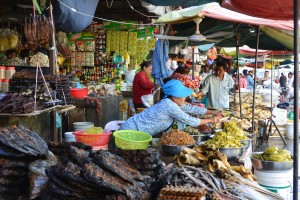 Psa Thmei
Psa Thmei
We crossed the quayside and down the dry banks to the ferry man who took us across the river to the monk school at Bovil Pagoda.
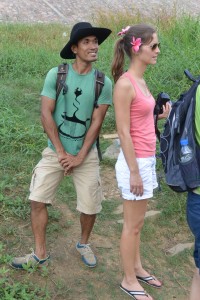
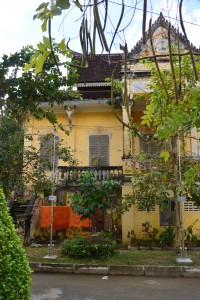 Manus & Lena crossing the river and a monk house at Bovil Pagoda
Manus & Lena crossing the river and a monk house at Bovil Pagoda
Singing rang out from the Catholic Church, which had the enthusiasm of an American black baptist congregation not the stilted formality of a Catholic communion. Time was getting short and the Bamboo Train beckoned so we had to forgo the black man in the middle of the road, another of Battambang’s attractions.
Giant wood spiders had weaved their webs over the rail tracks. The view extended across bright green rice fields to Phnom (hill) Sampeou in the distance.
A one-way system, lift off the bamboo platform, remove the axles and let the oncoming norrie through before putting it back together again.
 Nick (left), Lena & Sebastian on board a norrie
Nick (left), Lena & Sebastian on board a norrie
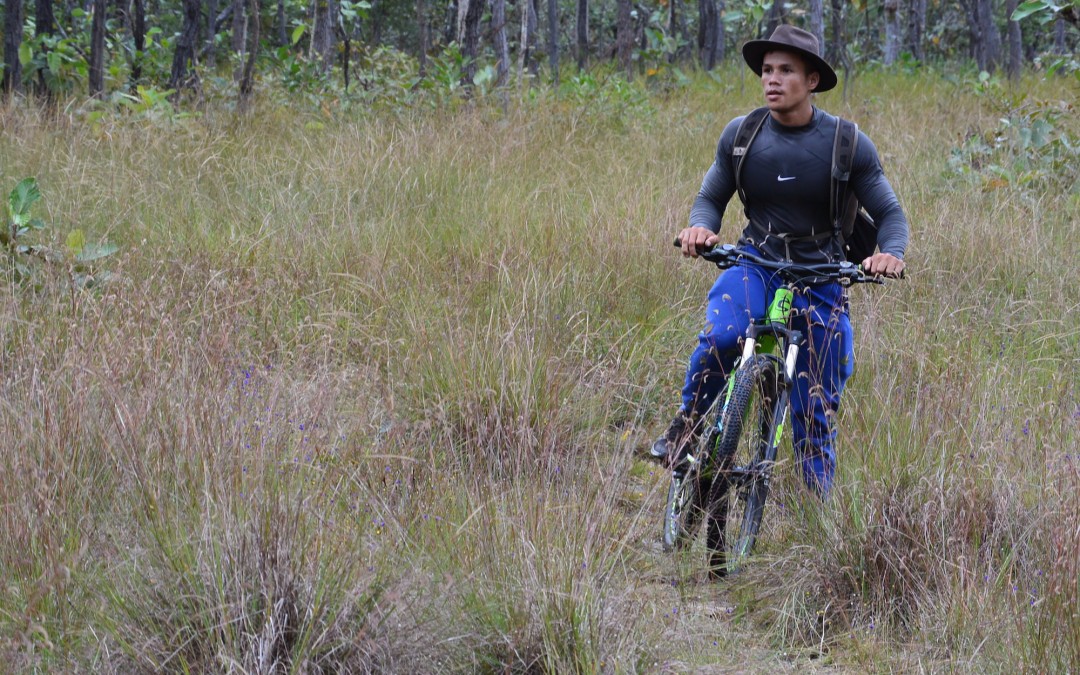
by Nick | Mar 19, 2020 | Bike, Blog
A Race to the Middle of Nowhere – The Scramble for Kulen with apologies to Thomas Packenham (The Scramble for Africa*)
We were about a thousand years too late but then it wasn’t for the first time, the Angkorians had been here before. And anyway the British, French, Germans and Italians took it in turns to claim large chunks of Africa*. I reckoned all we needed to do was plant an Indochine Exploration flag on the top of Phnom Srok, Mr Leang said was the tallest hill on Kulen, to guarantee safe rights of passage across Kulen for our Grasshopper guests the following week.
Lors had filled Kuong’s van with enough equipment to rival our pioneering colonial peers on a country conquering expedition. The ‘stuff’ wasn’t the half of what he’d be taking for the guests. We were just using hammocks to swing ourselves to sleep under the stars, though I wasn’t leaving it to chance and had my camping kit of Valium, whisky and ear plugs within easy reach.
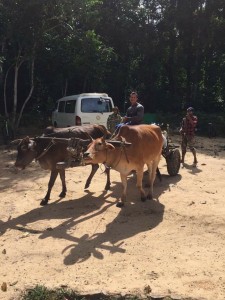 Loading Mr Chou’s oxcart
Loading Mr Chou’s oxcart
The escarpment up Kulen marks a departure from the dusty plains and chaos of Siem Reap. The forest canopy encloses a calm that penetrated even Kuong’s van. The MoE Station at Preah Ang Thom is where we start our trips and where we emptied the contents of the van onto Mr Chou’s Oxcart, while Phum – our guide for the next 24 hours, rode around the station getting used to the mountain bike we’d brought him.
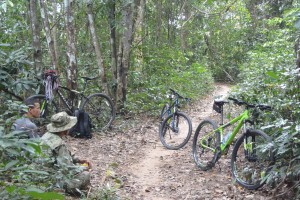 Our lunch spot
Our lunch spot
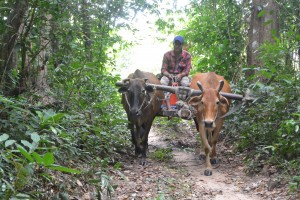 The guests arriving
The guests arriving
Lors fresh from his muscle contest in Phnom Penh and rippling in lycra, conducted our expedition as we embarked on our mission to cross the empty quarter by way of Porpel Village to Kbal Spean.
We followed a path between chamkar clearings that had been hacked and burnt out of the forest for the cashew nut plantations which, deplete the painstakingly accumulated fertility in a couple of years then wither to a scraggy halt.
We halted where the path went back under the trees and waited for Chou and his cows. Lors had bought a chicken for them. I’d got a squashed breakfast bagel from Little Red Fox. The chamkar finished at an escarpment and so apparently did our way. It was used to get timber out from the forest below but Phum told us that the illegal logging had stopped, incredible! He seemed to be right. It appeared that nobody had been this way for years. There was a path but it was so well disguised that when it changed direction I didn’t and came to an impromptu halt in the bushes*
 Relaxing* on the trail
Relaxing* on the trail
Chest high grass on the steep slopes gave way to forest as we reached the valley floor. Two years ago the saddest logging was taking out the remaining big trees. Now the vegetation was striking back, linking limbs to lock in the road and block the oxcarts that had born the bloodied corpses of felled trees.
We emerged out of the jungle into a flower-studded meadow bisected by the Kulen River. Our campsite was given away by rusty pilchard tins now hidden by the tall grass, evidence of Alistair’s (my previous business partner) search for Silver Langur Monkeys.
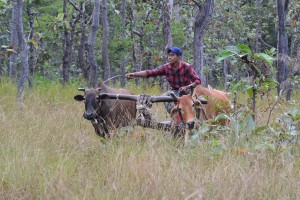 Arriving at the campsite
Arriving at the campsite
It seemed impossible that Phum and Chou would get the oxcart down the escarpment with no apparent path and then through the jungle so we headed back, fully expecting to abort our mission and spend the night in Anlong Thom. We found them a short way back hacking at a fallen tree, while the cows contentedly munched the leaves blocking their path.
 Lors and ….
Lors and ….
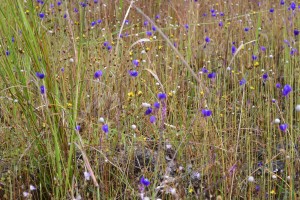 other flowers of the veld
other flowers of the veld
Our mission to cross Kulen was back within our grasp. Chou had a kettle on the boil while Lors and Phum set up the campsite and I drank tea.
 Lors and Phum preparing supper
Lors and Phum preparing supper
‘Nick get out of the way,’ warned Lors. Phum was flapping his hammock and stamping on the ground to get rid of black ants. ‘I cant get out of the way! Aaargh’ the little bastards stung, but they weren’t immune to deet.
Only a trickle of water made it down the stream despite the recent rain but the bathing pool remained. I reduced its surface tension by soaping up in the slightly cool water then went back to the campsite to drink beer and watch Lors shirtless cook dinner.
One week on from coming second in The Angkor Body-building Championships, it looked as if he could glide like a flying squirrel with his enormous deltoid muscles. Wielding a large bladed kitchen knife he alternated between slicing onions and swatting mosquitoes on Phum, for some reason remaining immune to their bites.
We were missing Dean but in his stead he’d sent a family sized pack of chicken casserole supposedly just for Lors and I, actually enough to feed all of us for dinner and breakfast. Beer then whisky as Lors and I contentedly chatted about nothing in particular. Mr Chou was wrapped in his hammock betrayed only by his gleaming white smile, 22 and with a baby on the way.
A full moon appeared through the canopy and shined silver on the bark of the trees that seemed to grow taller in the dark.

I lay in my hammock looking up through the branches at the stars, thinking that a simple camp in the forest was worth a million times more than whatever the 5 star Sachaya Resort on Bintan Island had cost where I’d been the week before.
The lingering chill from the night lifted as the sun lit up the leaves around us. Mr Chou and the ox-cart returned to rendezvous with Kuong, while we struck through the wilderness to find a route via the North Escarpment to Kbal Spean, not quite ready for how wild it turned out to be.
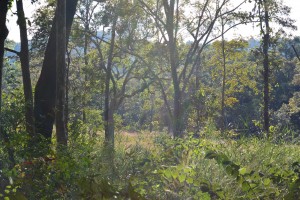
Elephant vomit or pig-shit grass life a soft fur covered our way but unlike soft fur it sticks its scratchy seeds to your socks and gets in your shoes. Enchanted glades of dipteropcarp deciduous trees gave way to dark caverns shaded by green and lit with white flowers on the forest floor.
The rocks and ruts were throwing me at every turn sapping confidence such that I pushed the bike as much as rode it.
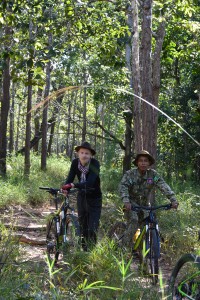 with Phum on the trail (left)
with Phum on the trail (left)
We met Leang the policeman with Chomran from Porpel village and two rangers with guns though it seemed unlikely they worked. A few months ago they’d arrested two loggers who were in jail and fined five others $1250 each. They were confiscating their chainsaws and fining the owners, which explained why the logging trail was disappearing. Leang had even seen the scratch marks of a bear at Kbal Spean and they reckoned they were still there in the Porpel Community Forest. An old bear had been hunted and killed for its bile. The hunter got $1000 and the middleman $6000 all for some fat ugly bong thom and his libido.
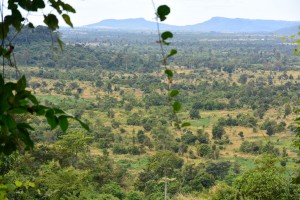 The North Facing Kulen Escarpment
The North Facing Kulen Escarpment
The North-facing escarpment had been logging central 2 years ago. Oxen and carts congregated with crude cut planks from freshly felled timber, which was stashed at the base of the cliffs and hidden so it couldn’t be spotted from the Wildlife Alliance helicopter that was surveying the mountain. Piled ready to be collected and taken out via the Forestry Administration HQ who extracted their toll and waited for the next batch to extort. Today there were no signs of logging.
Dr Livingstone I presume? Said Stanley, rather more usefully ‘would you like a beer?’ I was asked as we arrived at Kbal Spean. It had only taken 5 hours but as Dave Taylor had said the last time we attempted the route, while lying flat on the grass, ‘this is challenging,’ and technically not a mountain bike ride.
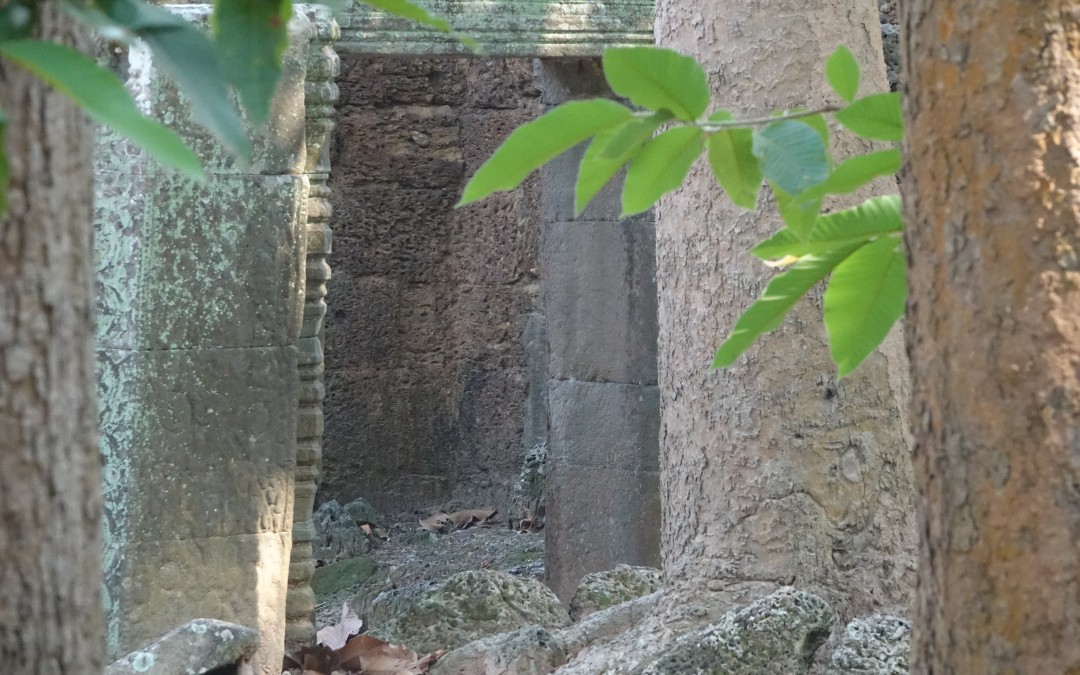
by Nick | Jan 29, 2020 | Angkor, Uncategorized
The Dry Season Temple Hunting Jeep Safari
We travel in reverse chronological order starting with 2 temples from the Bayon period.
The Buddhist king Jayavarman VII (or JVII for short) crammed into his thirty year rule the largest building program ever undertaken during the Angkorian era. At the center of his empire was the city of Angkor Thom and his state temple the Bayon.
Not far from the North Gate of Angkor Thom, off a red earth road and down a sandy track is Prasat Chan Ta Oun, once upon a time a Buddhist monastery.
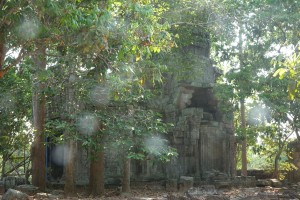 The central tower of Chan Ta Oun
The central tower of Chan Ta Oun
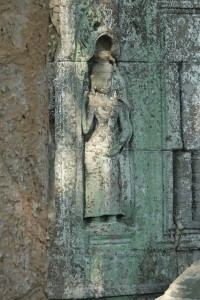 A divine figure from Buddhist mythology
A divine figure from Buddhist mythology
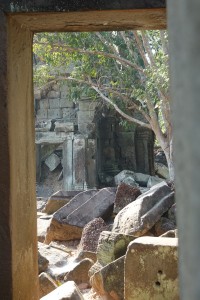 looking into the inner enclosure of Banteay Thom
looking into the inner enclosure of Banteay Thom
Banteay Thom also close to Angkor Thom* is built on a larger scale and harder to find, which is part of it’s charm.
*Thom being the Khmer word for big and Prasat means temple
There are two laterite walls with a moat in between and an entrance from the East. The inner enclosure is surrounded by galleries that can still be entered but not recommended for arachnophobes.
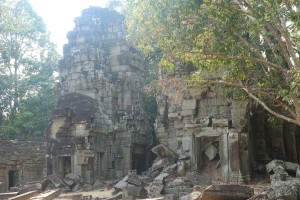 The central towers of Banteay Thom
The central towers of Banteay Thom
The three central towers that have been dug out for treasure are looked on by carvings of Buddha in his Bodhisvatta state of enlightenment.
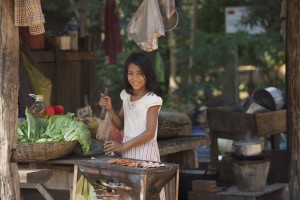 Phum Char (or Char Village)
Phum Char (or Char Village)
Small roads through stilted villages in countryside not much changed since the temples we visit were built. We’ll stop on our way to have a wander through and learn a little about what life is life in rural Cambodia.
We head back in time 200 years and along a red earth road to find Prasat Char (lit. temple of the palm tree) commissioned by Jayavarman V. There are clues as to its construction from the Sanskrit engravings in the stone doorframe.
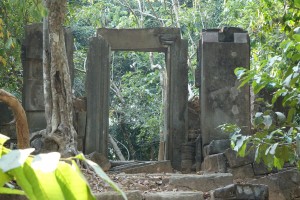 Prasat Char
Prasat Char
An uncertain fate is said to befall the translator as a five-headed dragon awaits those who understand the meaning of these runes.

Another 200 years back in time and we’re swapping the Angkorians for the preceding Chenla period when the Hindu brick temple of Prasat Kok Po was first built. ‘The Island Temple’ appears just that, set on a rise and surrounded by a rainy season moat.
 Prasat Kok Po
Prasat Kok Po
Restored by JIII in the 9th century as detailed in further Sanskrit engravings but this time with no dragons involved.
Spean Memay or Bridge of the mirror now crosses a dry field but once it lead from the North West corner of the close by West Baray, and headed to the Western borders of the Empire in Thailand.
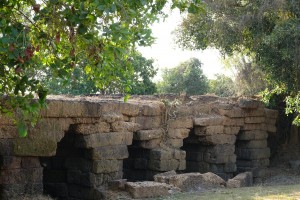 Spean Memay
Spean Memay
The bridge 79 meters in length and made up of 29 arches built in the 12th century survived Typhoon Ketsana, which washed away many modern bridges in 2009.
From Spean Memay we drive up onto the banks of The 11th century West Baray, which at 8km long and 2km wide was until the industrial revolution the world’s largest entirely man made reservoir.
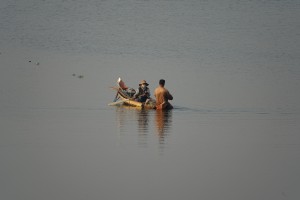 The West Baray
The West Baray
A permanent body of water that is still used to irrigate the rice fields to the South and Siem Reap’s beach resort. The traditional Sunday pass time for the family is to lie on a bamboo platform overlooking the water, drinking beer and gnawing BBQ’d chicken.
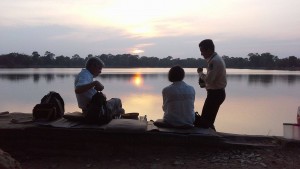
We’ll finish our temple hunting with a picnic lunch or a cold beer looking out across the water to the forests of Angkor behind.
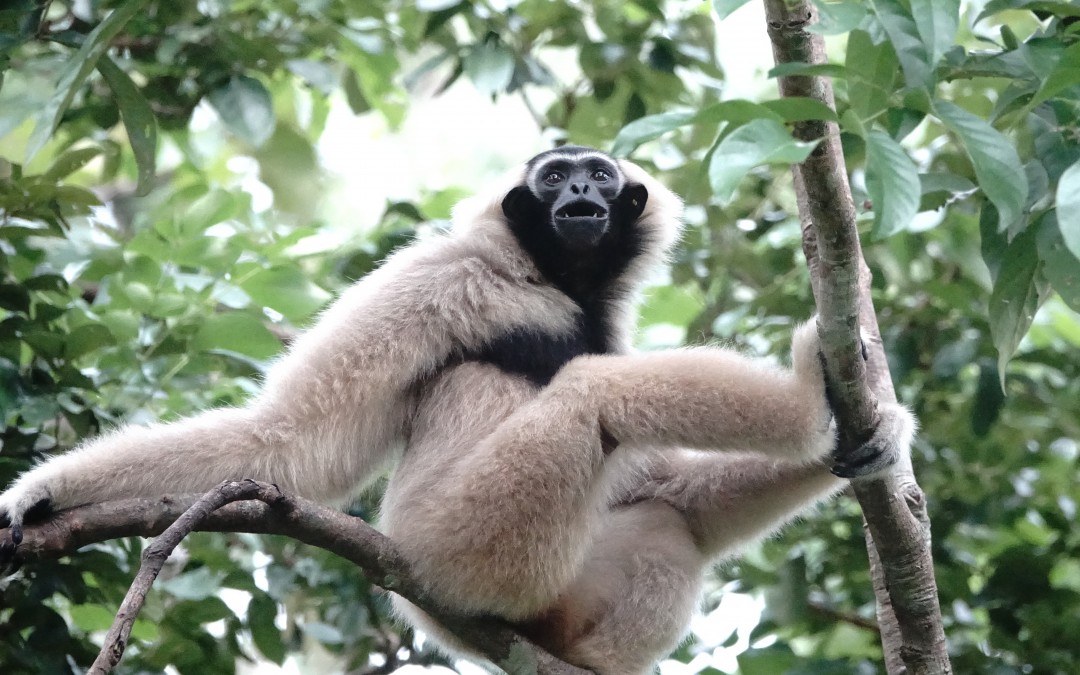
by Nick | Oct 11, 2019 | Bike, Blog, Conservation
A BeTreed Blog or The Adventures of BeTreed
BeTreed by myself in January 2017 (A BeTreed Adventure; https://indochineex.com/blog/a-betreed-adventure),
Then the Phnom Tnaut hike with Buntha and the boys. Hiking in the hills along snake trails and dodging trees while hanging from a zip-line.
And now retracing the forest paths to Preah Khan that we’d cycled with Laura and Ra.
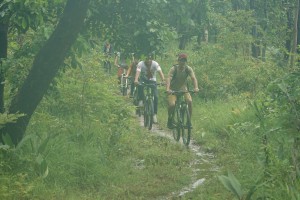 Manus leading the group on the forest path to Preah Khan
Manus leading the group on the forest path to Preah Khan
This time with Manus, my partner. I want to see the forest, he said. Buntha and Sreymom, my colleagues and friends – also wanted to come, then Veasna Buntha’s wife and Pov, the van driver, what was he going to do while we were playing in the forest? And finally Mengly the chef, we had to eat so he was welcome.
BeTreed is a lodge that Ben and Sharyn built from fallen timber, where guests can stay (including the fabulous tree-house) to experience the 6000Ha of community forest that Ben is protecting with a few rangers. It’s in the middle of a fast contracting no-where that’s difficult to get to in the dry season and now the rain is here it’s nigh impossible, as we found out.
There’s not much time, said Ben. The waters coming, he added. It all seemed to be going so well. NR6 was clear and Stoung within easy reach of Siem Reap. The new red earth road North had actually been paved most of the way. No rain, no wrong turn through three provinces all the way to the Preah Khan Baray, though we shouldn’t have been at Preah Khan or its Baray.
It was at this point the rain did come. A gentle drizzle at first but before long the clouds were spewing great blobs. We rang Ben but that didn’t help much. I can’t understand what he says face to face but over the phone impossible. Go back to the main road, which main road? The one you were on. That didn’t help. I tried a different tack, which village should we head for? Ben speaks better Khmer that English so I gave the phone to Buntha and we seemed to be on the right road for Ta Bos Village. That’s what I asked!
Ben was waiting in the village with his new pickup truck from the Ministry. We’ve got to go. We threw five of our bikes plus enough food to last a month, which was probably how long we’d be there if it didn’t stop raining, into the back of the truck and set off along the dirt track. Pov was locking up his van and had to run, jump and was caught by Manus and Mengly.
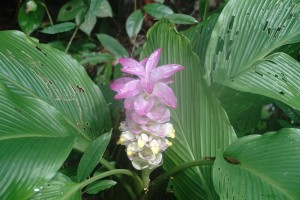 A forest flower
A forest flower
Buntha and I cycled crazy into the rain fuzzed night after the diminishing tail lights scared we’d loose the way.
We thought the car had sunk under the first torrent we crossed just in time to see it emerging on the other side. Energized we followed along the forest track to BeTreed. Drainage ditch planked crossings, rocks and fallen logs we couldn’t see. The trees blanked out what little light there was. Spasmodic bursts of lightening lit up the dark. Where the road turned we carried on into the bush then made a wrong turn. What to do lost in the forest in torrential rain?
Eventually after retracing our route the welcome chaos of BeTreed beckoned and we climbed the steps.
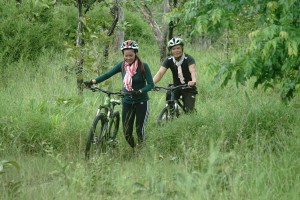 Veasna and Buntha
Veasna and Buntha
Buntha and I made puddles, Pov hovered while Mengly directed Sremom, Veasna and Manus as they sliced and chopped their way through the ingredients of dinner, which was spread out across the table as a vast array of food. I made introductions to Ben, Buntha and Sreymom who work with me, etc. and Manus. The relentless rain just kept pouring. Only 5% chance of precipitation today according to the forecast but more like a hurricane’s hit us, said Ben.
That didn’t help as we made our way up the hill to the tree house along what was now a river. At ten meters high there was a fair chance that the water wouldn’t reach our platform but it was doing its best to get through the roof, which sounded like a kettledrum from exploding water drops and thrashing branches.
We must have slept when the rain stopped and woke to a sodden forest so saturated that many of the branches were broken.
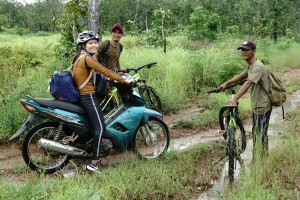 Sreymom, Manus and Try our guide
Sreymom, Manus and Try our guide
The forest was lush, it almost wobbled as we cycled. Mud filled ruts caught our wheels and prevented pushing the pedals. A dripping landscape of infinite biodiversity, Manus and Mengly who were leading the way saw a family of pigs. Sreymom fainted and traded her bicycle for Try, our guide’s motorbike. He followed ready to push her out when she got stuck. Veasna harrumphed and Buntha waited for her.
We left the forest into an illegal chamkar or cashew nut clearing. After Ben and his team cut down the saplings the farmer sprayed it with a sabotage of Roundup in 2017. Despite this it was already sprouting the green precursor to a forest.
Manus the self declared best biker was near the front at least until he got indigestion from eating too much, which coupled with exhaustion from the day meant he was going to die that night.
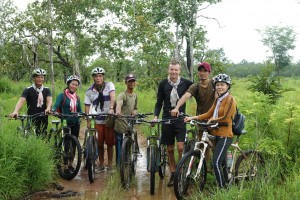 Left to right; Buntha, Veasna, Pov, Try, Nick, Manus and Sreymom
Left to right; Buntha, Veasna, Pov, Try, Nick, Manus and Sreymom
The hard exercise scarcely dented Try our guide. Also Mengly our chef appeared unfazed. I was tired and aching but kept going.
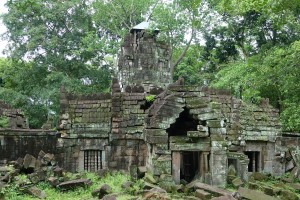 Prasat Preah Steung, part of the Preah Khan complex of temples
Prasat Preah Steung, part of the Preah Khan complex of temples
Finally we reached Ta Siem, the gastronomic capitol of Preah Vihear and had a nice omelet and cold beer in the local restaurant, while a child watched War of the Worlds set against a muddy market.
 Manus soaked in sweat after the ride
Manus soaked in sweat after the ride
We cheated and sent Pov ahead to fetch his van so we could look out over the soaked countryside from the comfort of the aircon vehicle in contrast to a mud clogged mountain bike.
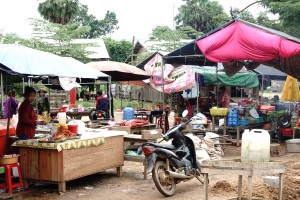 Ta Siem Village where we had lunch
Ta Siem Village where we had lunch
We regrouped at Ta Bos Village only to be met by a lake on the other side where the day before there had been a river. There was a bridge that Ben had built with most of Ta Bos village but not the owner of the paddy field, which you had to go through to get to it. A push me pull you of gods and demons as good and evil see-saws back and forth. There is no good that cannot be bad and visa versa (see Churning of the Sea of Milk. https://indochineex.com/blog/churning-sea-milk).
The thugs that helped Ben build the bridge later wanted to burn down his house. The paddy field owner thought only about her field and not the rest of the village.
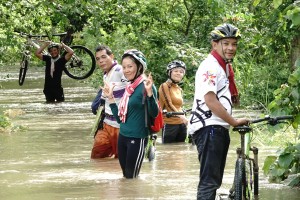 The ‘road’ from Ta Bos village to BeTreed that we’d driven the night before
The ‘road’ from Ta Bos village to BeTreed that we’d driven the night before
That was the easy part. The next flood had no excuse. There hadn’t even been a river the day before. But still we had to wade through, floating our bicycles across then return for the motorbike. Unsurprisingly the engine like everything else was flooded so we sent for Ben and his tool.
After a ‘cup o tea’ and a blissful bath in that empty period before dinner when we should have been supping a cold beer, I asked Ben to tell the story of Ta Bos Village and the Rosewood Tree.
Dense slow growing trees with a rosy tint to the wood and incredibly valuable, there was one big one left. They tried to cut it down with a handsaw but it was too dense so they came back with a chainsaw. Ben found it the next day and placed his rangers around the fallen trunk to catch the loggers when they came back to collect.
A tree so valuable was such big news a timber merchant got to hear of it and offered Ben $100,000 if he could get it legally signed off by the MoE. The provincial governor and minister agreed that Ben could sell the tree and use the money to help the local community.
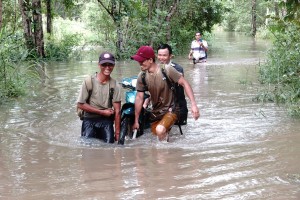 Carrying the motorbike across
Carrying the motorbike across
Back to the gods and demons, the commune chief wanted it for himself so he whipped up the local thugs who surrounded BeTreed and threatened to burn it down with or without Ben’s family inside. Ben called the governor who sent an army of military police with guns, which scared the thugs. They burnt the forest as they left.
Give it to them, said the governor. The commune chief and his thugs got the tree, sold it for a fraction of what it was worth and kept the money. It’s a daily battle that Ben wins while he can pay the police but he’s running out of money, what next?
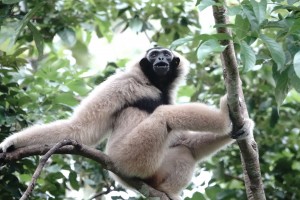 Molly the Pileated Gibbon
Molly the Pileated Gibbon
Too much! The table groaned under the weight of food, the team groaned with indigestion and Micky the three legged dog groaned with delight as copious left overs made their way onto the floor.
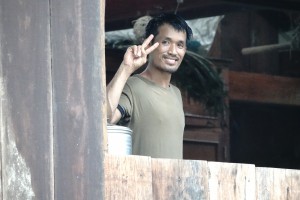 Manus the other gibbon
Manus the other gibbon
Palming a beer or two Manus and I left for the tree house, ten meters up amidst the forest canopy and now calm in the quiet evening after the crashing rain last night
The calm didn’t last as Manus woke me for the third time with a plaintiff plea for medicine. We traipsed down the hill past a poised pit viper to the lodge to get our first aid kit. Just give him Paracetamol said Ben when we woke him, which meant go away. Combined with Valium and Ibuprofen it was enough to make Manus pass out, snore all night and wake refreshed.
Breakfast was another enormous meal. Don’t eat too much. Can I cycle? No you were dying last night. Ben took those that didn’t want to ride and their bikes in his truck with the idea that he’d drop them off at the high tide’s edge. As fast as it had come up the water had receded so he drove through to the village.
I glowered at any young man who came into eyeshot and felt that no one gave a fuck about anyone else or anything. Like the emaciated dog that got caught under Ben’s truck and now lay in the middle of the road with its brains leaking out. Even Try who’d been my hero the last time I came now won’t work for Ben after he’s taken guests and got a tip.
I swallowed a big lump after Ben had dropped us off in Ta Bos village and said goodbye. The enormity of what he’s trying to achieve for people who don’t care struck home. Uncouth certainly but a hero who dedicates his life for what he believes in; conservation, biodiversity & beauty when the world seems set on greed, destruction and uniformity.
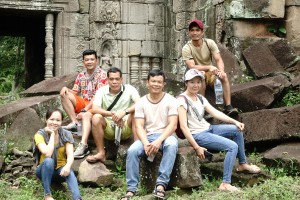 The Team at the East Entrance to Preah Khan including Mengly (2nd left)
The Team at the East Entrance to Preah Khan including Mengly (2nd left)
Preah Khan -Kampong Svai (that’s where it is). We got here yesterday but were too tired to take in the temple. JVII’s first, he built it while amassing an army to oust the revolting Cham from Angkor. (read https://indochineex.com/blog/angkor/story-jayavarman-vii-told-temples)
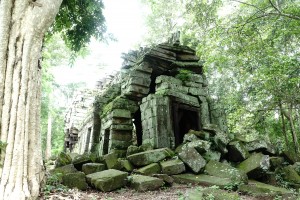 Inside Preah Khan
Inside Preah Khan
Ta Prohm with its twisted tree roots and Beng Melea with its meandering boardwalks, are described as the jungle temples of Angkor but its Preah Khan that really feels like the forgotten forest temple.
A few structures remain relatively intact and there’s been some restoration or shoring up, but most of the complex is littered with carved blocks adorned by butterflies that damp morning.
It seemed too soon that Manus was calling for me to leave as the rest of the team waited by the van.
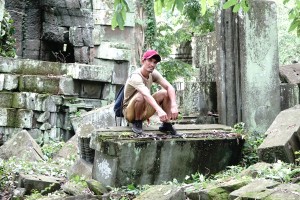 The other gibbon inside Preah Khan
The other gibbon inside Preah Khan
And that was the end of the adventure or so we thought but not quite as we still had fifty meters of flooded road to cross, South of Ta Siem, pulled by a kroyun for 15,000R (~$4).
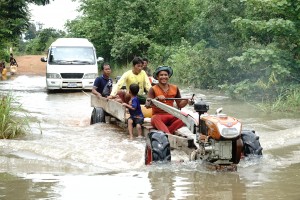 Just when we thought it was all over – heading South to Stoung
Just when we thought it was all over – heading South to Stoung
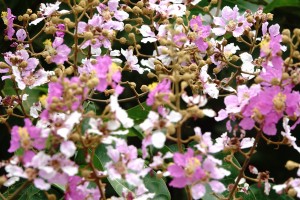 A flower to finish
A flower to finish
Indochine Exploration is pleased to partner with and support BeTreed www.betreed.com with mountain bike and hiking adventures. Please contact us at info@indochineex.com

 The Institute of Languages showing the cooling polygon roof and shading vertical panels
The Institute of Languages showing the cooling polygon roof and shading vertical panels The main building in The Institute of Languages showing the larger 2nd & 3rd floors shading the ground floor and stage
The main building in The Institute of Languages showing the larger 2nd & 3rd floors shading the ground floor and stage  The 4 Lecture Halls
The 4 Lecture Halls The Conference Hall
The Conference Hall Interior
Interior A Hundred House
A Hundred House The royal pavilion (top right) with a War of the Worlds timing box over the VIP seats
The royal pavilion (top right) with a War of the Worlds timing box over the VIP seats External staircase and tiered seating showing the ventilation holes
External staircase and tiered seating showing the ventilation holes One of the pools surrounding the auditorium showing the guttering and reflecting the stairs
One of the pools surrounding the auditorium showing the guttering and reflecting the stairs 1 of the 4 columns supporting a square 32m span and the tiered seating illuminating the auditorium
1 of the 4 columns supporting a square 32m span and the tiered seating illuminating the auditorium View across the pitch to central auditorium, Royal Box and VIP seating with towers at the 4 cardinal points
View across the pitch to central auditorium, Royal Box and VIP seating with towers at the 4 cardinal points

 Banteay Chma
Banteay Chma Taking off from Siem Reap Airport
Taking off from Siem Reap Airport
 Loksvara (left) Bas-relief on outer gallery wall
Loksvara (left) Bas-relief on outer gallery wall
 A temple with a view.
A temple with a view. Prasat Thom to Prasat Prang @ Koh Ker
Prasat Thom to Prasat Prang @ Koh Ker Prasat Prang
Prasat Prang At the entrance to Preah Khan in 2009
At the entrance to Preah Khan in 2009
 A silk cotton tree as seen through the broken doorway of a temple (above) and part of the Bakan being reclaimed by the forest
A silk cotton tree as seen through the broken doorway of a temple (above) and part of the Bakan being reclaimed by the forest 
 Pit Viper in tree beside boat
Pit Viper in tree beside boat Seb and Lena setting off from their homestay
Seb and Lena setting off from their homestay Sunset over the Prek Toal Core Bird reserve
Sunset over the Prek Toal Core Bird reserve Dawn over Prek Toal
Dawn over Prek Toal

 The salapali or space for teaching of Wat Cheu Kmao
The salapali or space for teaching of Wat Cheu Kmao Grey-headed Fish Eagle
Grey-headed Fish Eagle A floating house being towed to deeper water through a village of stilted houses
A floating house being towed to deeper water through a village of stilted houses The stilted houses lining the still flooded banks of the middle Sangke River
The stilted houses lining the still flooded banks of the middle Sangke River A pagoda on the riverbank not far from Battambang
A pagoda on the riverbank not far from Battambang Psa Thmei
Psa Thmei
 Manus & Lena crossing the river and a monk house at Bovil Pagoda
Manus & Lena crossing the river and a monk house at Bovil Pagoda Nick (left), Lena & Sebastian on board a norrie
Nick (left), Lena & Sebastian on board a norrie
 Loading Mr Chou’s oxcart
Loading Mr Chou’s oxcart Our lunch spot
Our lunch spot The guests arriving
The guests arriving Relaxing* on the trail
Relaxing* on the trail  Arriving at the campsite
Arriving at the campsite  Lors and ….
Lors and …. other flowers of the veld
other flowers of the veld Lors and Phum preparing supper
Lors and Phum preparing supper

 with Phum on the trail (left)
with Phum on the trail (left) The North Facing Kulen Escarpment
The North Facing Kulen Escarpment
 The central tower of Chan Ta Oun
The central tower of Chan Ta Oun A divine figure from Buddhist mythology
A divine figure from Buddhist mythology looking into the inner enclosure of Banteay Thom
looking into the inner enclosure of Banteay Thom The central towers of Banteay Thom
The central towers of Banteay Thom Phum Char (or Char Village)
Phum Char (or Char Village) Prasat Char
Prasat Char
 Prasat Kok Po
Prasat Kok Po Spean Memay
Spean Memay  The West Baray
The West Baray

 Manus leading the group on the forest path to Preah Khan
Manus leading the group on the forest path to Preah Khan A forest flower
A forest flower Veasna and Buntha
Veasna and Buntha Sreymom, Manus and Try our guide
Sreymom, Manus and Try our guide Left to right; Buntha, Veasna, Pov, Try, Nick, Manus and Sreymom
Left to right; Buntha, Veasna, Pov, Try, Nick, Manus and Sreymom Prasat Preah Steung, part of the Preah Khan complex of temples
Prasat Preah Steung, part of the Preah Khan complex of temples Manus soaked in sweat after the ride
Manus soaked in sweat after the ride Ta Siem Village where we had lunch
Ta Siem Village where we had lunch The ‘road’ from Ta Bos village to BeTreed that we’d driven the night before
The ‘road’ from Ta Bos village to BeTreed that we’d driven the night before Carrying the motorbike across
Carrying the motorbike across Molly the Pileated Gibbon
Molly the Pileated Gibbon Manus the other gibbon
Manus the other gibbon The Team at the East Entrance to Preah Khan including Mengly (2nd left)
The Team at the East Entrance to Preah Khan including Mengly (2nd left) Inside Preah Khan
Inside Preah Khan The other gibbon inside Preah Khan
The other gibbon inside Preah Khan Just when we thought it was all over – heading South to Stoung
Just when we thought it was all over – heading South to Stoung A flower to finish
A flower to finish